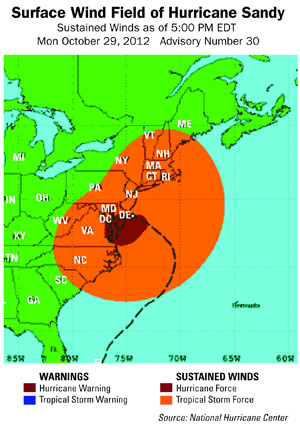Risk Management Solutions says storm Sandy's impact on the East Coast is “much more severe” than last year's Hurricane Irene, and the catastrophe modeler expects insured losses from Sandy to eclipse the $4.5 billion in losses from Irene.
Modeler Eqecat said yesterday that it expected damage from Sandy to be comparable to Irene, and released an initial insured-loss estimate of $5 billion.
 And as emergency personnel, modelers and insurers move to assess the ultimate damage from Sandy, some interests have connected the storm to hot topics such as federal risk-management strategies, insurers' disaster responses, and climate change.
And as emergency personnel, modelers and insurers move to assess the ultimate damage from Sandy, some interests have connected the storm to hot topics such as federal risk-management strategies, insurers' disaster responses, and climate change.
Sandy came ashore along the coast of southern New Jersey as an extra-tropical cyclone, although maximum sustained winds at landfall were 80 miles per hour, in the lower Category-1 range. The National Hurricane Center (NHC) says the center of Sandy tracked about five miles southwest of Atlantic City, New Jersey and around 40 miles northeast of Cape May, New Jersey.
As of 11 a.m. EDT, the storm was further inland, about 145 miles west of Philadelphia, according to the NHC, but maximum sustained winds are down to 45 miles per hour. The storm has slowed, says the NHC, and it is expected to continue west throughout the day before turning toward Western New York tonight and moving into Canada on Wednesday.
“The effects are very far reaching due to the size of the storm,” says RMS in a statement. “Expect to see a lot of building damage and auto damage due to tree fall over a wide area. Business interruption, fire-following damage, coastal-surge damage, and inland flooding will all contribute to the total losses.”
The catastrophe modeler says over 7 million people across 15 states are without power.
RMS adds that inland damage typically seen during winter storms is also expected. The Associated Press reports that, in West Virginia, winds spinning off of Sandy produced blizzard conditions over parts of the state, causing snow accumulations of over a foot in lower elevations and more than two feet in higher elevations.
Meanwhile, the more traditional tropical-cyclone risks of wind, water and storm surge wreaked havoc on coastal areas. CBS News reported last night that areas in New York City endured record storm surge, including surge measurements of 13.88 feet at Battery Park in southern Manhattan. Elsewhere, RMS says surge measurements were 14.6 feet at Bergen Point West, N.Y., and 13.31 feet at Sandy Hook, N.J. Images on TV throughout the night on Oct. 29 showed regions from southern New Jersey to the Hudson Valley in New York inundated with floodwaters from the combined forces of storm surge and tidal forces driven by the full moon.
RMS says, “The event is fairly unusual due to the size of wind field and the track path, i.e. making direct hit on coast and traveling far inland rather than skirting coastline.”
RMS notes that Sandy impacted “a very densely populated region which has very high insured-exposure values.” In New York City alone, where damage consists of blown-out windows and flooding, there is $2.1 trillion worth of insured property, RMS says.
INSURANCE INDUSTRY PREPARES
As for insurers, it remains too early to give estimates on claim counts or losses. Laura Strykowski, senior corporate relations manager for Allstate, says the insurer has approximately 1,100 claim personnel staged for deployment, and in its catastrophe centers. “Once authorities give clearance to enter the affected areas, agents and the catastrophe team will be available to help Allstate policyholders start the claim process, Strykowski says via email.
Credit Suisse analysts say in a research report that the storm is likely to wipe out the fourth-quarter earnings of Chubb, Allstate and Arch Capital Group.
Officials of the Property Casualty Insurers Association of American and the National Association of Mutual Insurance Companies say the severity of the storm appears to vary greatly, with the greatest impact in New York, New Jersey and Connecticut.
Frank O'Brien, PCI vice president, state government relations, says the industry stands ready to pay all claims. “The insurance industry is well-capitalized and well positioned, and will be able to handle the financial impact,” he states. “There are no solvency concerns here.”
Neil Alldredge, NAMIC's senior vice president, state & policy affairs, says there may be fewer losses from coverages provided under the National Flood Insurance Program and more losses from commercial coverages such as business interruption, although he notes small businesses are provided coverage through the NFIP.
Fitch Ratings said before landfall that losses from Sandy would likely be “largely borne by primary insurers,” but noted that its early assessment was uncertain.
“We expect the brunt of losses to be borne by primary writers, including State Farm, Allstate, Liberty Mutual Group, and Travelers, based on market share positions in the Mid-Atlantic and New England regions,” Fitch said.
NEXT PAGE: KATRINA-RESPONSE CRITICISMS, CLIMATE CHANGE, AND FEDERAL POLICY
The Consumer Federation of America, meanwhile, criticized insurers' response to 2005's Hurricane Katrina and warned against a similar response to Sandy. “Insurers treated many people poorly who filed claims for damages caused by Hurricane Katrina,” CFA says in a statement. “For example, after Hurricane Katrina, insurers pulled back from offering coverage along the coasts, dumping people into higher priced, state run insurance pools. They also cut coverage and raised rates substantially.”
Regarding a response to Sandy, CFA says, “There is no reason, actuarially, for insurers to raise rates or cut back coverage due to Hurricane Sandy, which is a storm well within the projections of insurers' current rate schedules. Insurers have already raised prices and cut back coverage along the East Coast of America and no further price or coverage action is called for.”
INTERESTS TAKE ON THE 'WHY?'
As insurers wait to get into affected areas to assess damage, some are beginning to point to the event as evidence in support of larger issues. Ceres, an environmental group made up of investors that was instrumental in getting the National Association of Insurance Commissioners' Climate Change Risk Disclosure Survey off the ground in 2009, says the storm is a sign of changing weather patterns driven by climate change. In a statement, Ceres says, “Hurricane Sandy's impact on a region that is not typical for hurricanes begs the question: are extreme weather trends and anticipated future impacts due to climate change creating significant challenges across the country for the insurance industry?”
The R Street Institute pointed to the damage from the storm as a reason against developing in risky areas. In a statement, R Street “suggested the storm should heighten awareness about the dangers of federal policies that encourage development in risk-prone areas.”
R Street Senior Fellow R.J. Lehmann speaks to the potential impact on the National Flood Insurance Program: “It appears likely that Sandy will exhaust the NFIP's remaining $3 billion of statutory borrowing authority, meaning it will need to request more money from Congress to pay its claims.”
He adds, “In the short term, we would insist the NFIP use its existing authority to raise rates, buy reinsurance and issue catastrophe bonds, so that the private market, rather than taxpayers, assume the risk of these sorts of catastrophes in the future. Over the longer term, further NFIP reform must include phasing in actuarial rates for all policies, and possibly selling some of the NFIP's 5.6 million policies to private insurers.”
Additional reporting by Arthur D. Postal
Want to continue reading?
Become a Free PropertyCasualty360 Digital Reader
Your access to unlimited PropertyCasualty360 content isn’t changing.
Once you are an ALM digital member, you’ll receive:
- Breaking insurance news and analysis, on-site and via our newsletters and custom alerts
- Weekly Insurance Speak podcast featuring exclusive interviews with industry leaders
- Educational webcasts, white papers, and ebooks from industry thought leaders
- Critical converage of the employee benefits and financial advisory markets on our other ALM sites, BenefitsPRO and ThinkAdvisor
Already have an account? Sign In Now
© 2024 ALM Global, LLC, All Rights Reserved. Request academic re-use from www.copyright.com. All other uses, submit a request to [email protected]. For more information visit Asset & Logo Licensing.








